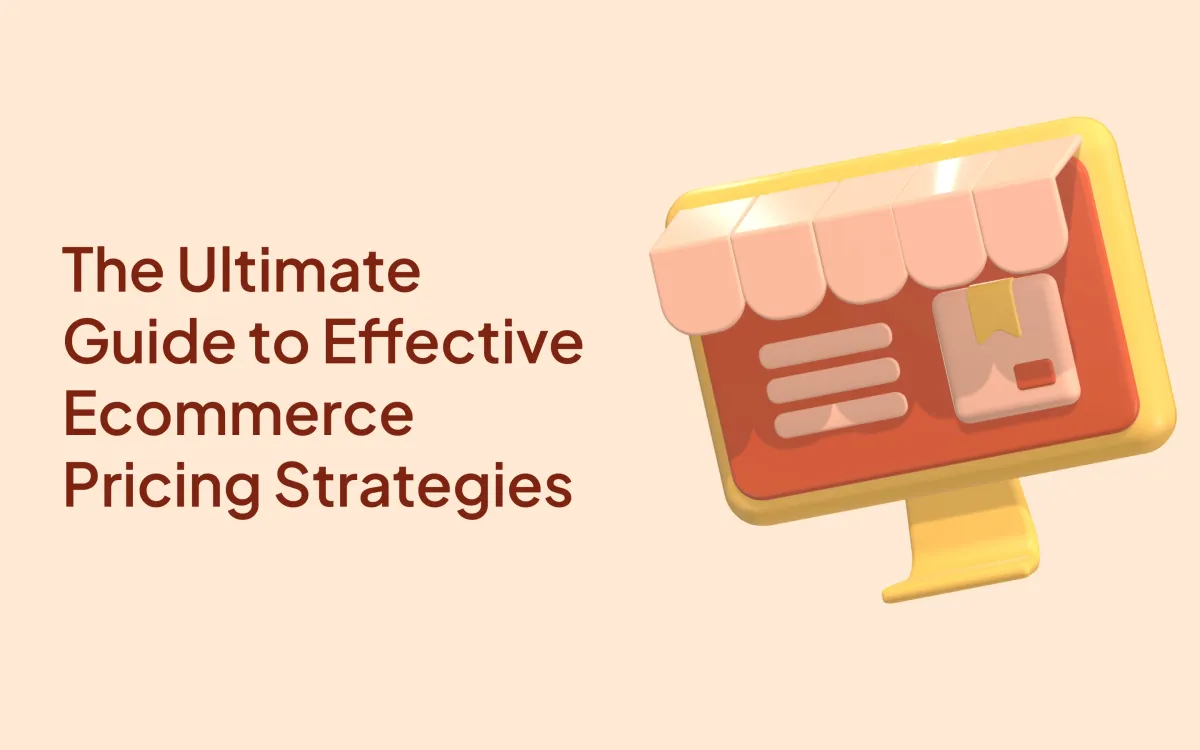The Ultimate Guide to Effective Ecommerce Pricing Strategies
Discover the ultimate guide to effective eCommerce pricing strategies, including tips on setting competitive, value-based, and dynamic prices.

Are you wondering how to set prices for your online store? Choosing the right pricing strategy is crucial for any eCommerce business, impacting everything from sales volume to profit margins.
In this guide, we'll explore why pricing strategies are so important in the digital marketplace and how selecting the right one can not only drive more sales but also significantly increase your profits.
Whether you're just starting out or looking to refine your approach, understanding these strategies will provide you with the tools you need to succeed.
Definition of eCommerce Pricing Strategies
eCommerce pricing strategies refer to the various approaches and tactics that online retailers and businesses use to set prices for their products and services.
An eCommerce pricing strategies are designed to optimize revenue and profits by considering factors such as market demand, consumer behavior, competitor pricing, and cost of goods.
The goal is to find a price point that attracts customers, maximizes sales, and enhances the overall value perception of the brand in the competitive online marketplace. Effective eCommerce pricing strategies are dynamic and adaptable, allowing businesses to respond quickly to market changes and consumer trends to maintain a competitive edge.
Terms Associated with eCommerce Pricing Strategies

1. Dynamic Pricing
Dynamic pricing is a strategy where you adjust the prices of your products based on various factors like how much customers want the product at a certain time, what similar stores are charging, and even the time of day.
It’s similar to how airline prices change; a seat on a plane might be cheaper if you book it months in advance and more expensive as the flight date gets closer and seats become less available.
Why use it? Using dynamic pricing in your eCommerce store can be very beneficial. It allows you to be flexible with your pricing strategy, adapting to market conditions to maximize your sales and profits. For example, if you're selling sunscreens, you might increase the price during the summer when demand is high and decrease it during the winter to clear out inventory.
Example: Imagine you run an online store selling concert tickets. By using dynamic pricing, you could set lower prices when a concert is first announced and gradually increase them as the event date approaches and tickets become scarcer. This approach not only helps in selling tickets efficiently but also maximizes revenue as fans are willing to pay more closer to the event date.
This method ensures that you are always offering competitive prices and can respond quickly to any changes in the market, keeping you one step ahead in a fast-paced eCommerce environment.
2. Penetration Pricing
Penetration pricing is a strategy where you set your prices lower than usual when you first enter a new market. The idea is to make your products so affordable that a large number of people are tempted to try them.
This approach is particularly useful if you're a new player in a market with established competitors and you need a strong strategy to grab market share quickly.
Benefits:
The main advantage of penetration pricing is that it helps you quickly attract a lot of customers. These initial customers can provide valuable feedback, spread the word about your products, and even become loyal buyers. By offering lower prices, you also make it harder for competitors to match your prices without hurting their margins, giving you a competitive edge.
Example:
Imagine you start selling a new brand of organic tea online. Instead of pricing your tea similarly to competitors, you set the price significantly lower. This low price draws the attention of tea enthusiasts who are always looking to try new products but are sensitive to price. As these early customers enjoy your tea, they start recommending it to friends and posting about it on social media, naturally creating buzz around your brand. Once your customer base is established and your brand becomes recognized, you can gradually increase the price to a more sustainable level.
By using penetration pricing, you not only gain quick access to a new market but also lay a strong foundation for future growth and brand recognition.
3. Skimming Pricing
Skimming pricing is a strategy where you set high prices at the launch of a new and unique product. This approach targets early adopters who are willing to pay a premium to have the latest and greatest first. Over time, as the initial excitement decreases and more competitors enter the market, you gradually lower the price to attract a broader customer base.
When to use: Skimming pricing works best for innovative or luxury products where you are first to market, and there's little to no competition. It’s ideal when your product offers distinct advantages or features that can’t be found elsewhere, allowing you to capitalize on the lack of alternatives available to consumers.
Example: Consider a tech company launching a revolutionary new smartwatch with cutting-edge features like augmented reality capabilities. Initially, the company might price this smartwatch high, targeting tech enthusiasts and gadget lovers who are eager to experience the newest technology, regardless of cost.
These early buyers not only provide revenue at higher margins but also serve as brand ambassadors, sharing their experiences and generating interest. As competitors begin to launch similar products and the initial novelty fades, the company can lower the price to appeal to more price-sensitive consumers who were hesitant about the initial high cost.

4. Psychological Pricing
Psychological pricing is a strategic way to set prices that influence a customer's perception, making them more likely to buy based on emotional rather than rational responses.
The most common technique is to set prices just below a whole number, which can make a product appear significantly cheaper in the eyes of consumers. For example, pricing an item at $9.99 instead of $10 makes it seem closer to $9, which feels like a better deal.
Examples:
- Charm Pricing: As mentioned, setting prices like $9.99 instead of $10. The small decrease can significantly affect customer perception, making the item appear more affordable.
- Limited-Time Offers: Using terms like “Sale ends tomorrow” creates a sense of urgency, pushing customers to make a purchase decision quickly to take advantage of a perceived deal.
- Buy One Get One Free (BOGO): This is another psychological tactic where customers feel they are getting more value for their money, prompting them to buy more than they initially planned.
5. Bundle Pricing
Bundle pricing is a strategy where you group several products together and sell them at a lower total cost than if the items were purchased individually.
Bundle pricing can lead to several advantages: it increases the perceived value for customers, encourages them to buy more items at once, and helps clear out inventory faster. By offering a bundle, you also make shopping more convenient for customers, as they can buy several related items in one go.
Strategies:
- Bundle Complementary Items: Group products that naturally go together to enhance customer value. For example, if you're selling cameras, offer a bundle that includes a camera bag, a memory card, and a lens cleaning kit.
- Tiered Bundling: Create bundles at different price points to cater to various customer needs and preferences. This can include basic, standard, and premium bundles, each adding more products or services.
- Seasonal or Thematic Bundling: Offer bundles that are relevant to a particular season or event, like a back-to-school bundle that includes notebooks, pens, and a calculator.
6. Discount Pricing
Discount pricing involves reducing the price of products temporarily to attract more customers and boost sales. Here are a few common types of discounts:
- Seasonal Discounts: These are offered during specific times of the year, such as holiday seasons or end-of-season sales. For example, many retailers offer discounts during the Christmas shopping season to capitalize on increased consumer spending.
- Buy One Get One Free (BOGO): This type of discount encourages customers to buy more by offering additional items at no extra cost. For instance, "Buy one t-shirt, get another one free" is a popular BOGO deal in clothing stores.
- Bulk Discounts: Offered to customers who buy large quantities, encouraging larger purchases. For example, a store may offer a 10% discount on orders over $100.
7. Geographic Pricing
Geographic pricing involves adjusting the price of products or services depending on where the customer is located. This strategy recognizes that customers in different areas might have different levels of income, face varying levels of competition, or incur different costs, such as shipping fees or taxes.
Example in Practice:
Let’s say you run an online clothing store based in New York City and you want to sell nationwide. You notice that shipping to California costs more than shipping to nearby New Jersey. Using geographic pricing, you might set slightly higher prices for customers in California to cover the additional shipping costs. Similarly, if you're selling in both the U.S. and Canada, you might adjust prices in Canadian markets to account for higher duties and taxes that Canadian customers have to pay, ensuring that your products remain competitively priced.
8. Freemium Pricing
Freemium pricing is a popular business model, especially in digital products and services, where you offer a basic version of your product for free while charging for more advanced features or capabilities. The free version attracts users by removing the financial barrier to entry, giving them a taste of what you offer. The goal is to provide enough value in the free version to entice users to upgrade to the paid version, which includes additional, more powerful features.
Example in Practice: A good example is a mobile app for language learning. The app offers basic lessons and vocabulary for free, which anyone can access after downloading the app. However, advanced features like interactive conversations with native speakers, specialized courses for business or medical language, and an ad-free experience are available only in the premium version.

9. Loss Leader Pricing
Loss leader pricing is a strategic approach where a business sells a product at a price that is not profitable — sometimes even at a loss — to attract customers.
The idea is that once customers are drawn in by the low-priced item, they will also purchase other products that are priced to generate a profit. This method is often used to increase traffic to a store or a website, with the hope that the overall sales from additional purchases will offset the loss from the initial product.
Example in Practice: A classic example of loss leader pricing is seen in grocery stores. A store may sell milk at a very low price, knowing that milk is a staple item that attracts shoppers. Once customers are in the store for the cheap milk, they are likely to pick up other groceries with higher margins, like specialty cheeses or organic produce. The loss on milk is offset by the profits from these additional purchases.
10. Value-Based Pricing
Value-based pricing is a strategy where the price of a product or service is set primarily based on the perceived value to the customer rather than on the cost of production or market competition. This means that if customers believe a product is worth more, they will be willing to pay more, regardless of how much it actually costs to produce.
Example in Practice:
A great example of value-based pricing can be seen in the software industry, particularly with SaaS (Software as a Service) products. For instance, a project management tool might offer basic features at a low price for individual users but charge much higher rates for enterprise versions that include advanced features like greater security, more integrations, and extended support, which large businesses highly value.
11. Cost-Plus Pricing
Cost-plus pricing is a straightforward pricing strategy where you calculate the total cost of producing a product, and then add a fixed percentage on top to determine the selling price. This added percentage represents your profit margin. Essentially, you’re ensuring that each sale covers the cost of the item and contributes a predictable amount of profit.
Example in Practice: Imagine a company that makes handmade candles. The cost to produce one candle (including materials, labor, and overhead) is $5. Using cost-plus pricing, the company decides to add a 50% profit margin, resulting in a selling price of $7.50 per candle.
12. Competitive Pricing
Competitive pricing is a strategy where you set the prices of your products based on what your competitors are charging. Instead of calculating prices solely based on costs or perceived value, you look at the prices of similar products in the market and adjust your prices to match or undercut your competitors.
Competitive pricing is particularly common in industries where products are similar and customers are price-sensitive, such as electronics or basic groceries.
Example in Practice: Consider a local electronics store that sells smartphones. If a nearby competitor lowers the price of a popular model, the store might also lower its price to ensure it doesn’t lose customers to the competitor. Similarly, if the store finds that it has the lowest price among competitors for a high-demand item, it might slightly increase its price to improve profit margins without exceeding the market average.
Another example could be an online book retailer. Using competitive pricing, they might track prices of bestsellers and new releases on major platforms like Amazon and Barnes & Noble. If these competitors offer a discount on a popular novel, the retailer might also lower their price to attract buyers looking for the best deal.

13. Anchor Pricing
Anchor pricing is a strategy where you set a high initial price (the "anchor") for a product and then offer the product at a lower price next to it.
This high anchor price sets a psychological benchmark in the customer's mind, making the lower price seem much more attractive in comparison. It's like when you see a sweater originally priced at $100 marked down to $70; the original price serves as the anchor, making the discount appear more significant.
Example in Practice:
Imagine a furniture store that wants to sell an overstocked sofa. They might initially list the sofa at $1,500 but place it on sale for $1,000. Customers seeing the original price of $1,500 as the anchor will perceive the sale price as a significant deal, which might motivate them to buy the sofa more than if it were just listed at $1,000 from the start.
14. Premium Pricing
Premium pricing is a strategy where you charge higher prices for your products because they are perceived as more valuable, luxurious, or superior in quality.
Premium pricing is based on the idea that a higher price point can actually enhance the appeal of a product by suggesting that it is a luxury or top-of-the-line item. Customers often associate higher prices with higher quality, exclusivity, and prestige.
Example in Practice:
A classic example of premium pricing is seen in the smartphone market. Consider a high-end smartphone brand like Apple, which often prices its newest models significantly higher than many other phones on the market.
These phones are not just tools for communication; they are seen as a status symbol, known for their sleek design, innovative technology, and strong brand reputation. Apple's premium pricing strategy reinforces the perception that its products are luxurious and cutting-edge.
15. Seasonal Pricing
Seasonal pricing involves adjusting the prices of products or services based on the time of year or season.
Seasonal pricing strategy recognizes that demand for certain items can fluctuate significantly throughout the year due to changes in weather, holidays, or cultural events. By adjusting prices in response to these changes in demand, businesses can maximize their sales and profits.
Example in Practice: Consider an ice cream shop located in a region with distinct summer and winter seasons.
During the hot summer months, demand for ice cream is high, and the shop might increase its prices slightly because customers are more willing to pay a premium for a cool treat. However, in the winter, demand drops significantly, and the shop might lower prices or offer special promotions to attract customers, like "buy one, get one free" deals.
Another example is an online clothing retailer that sells seasonal apparel. In the lead-up to winter, the retailer might increase prices on coats and winter gear as people prepare for colder weather. But as winter ends and spring approaches, these items might be discounted heavily to clear out inventory before introducing spring collections.
Conclusion
Pricing strategies are a powerful tool in the success of any eCommerce business. By understanding and implementing the right approach—whether it’s dynamic pricing, penetration pricing, or any of the other strategies we’ve discussed—you can better position your products in the market, attract more customers, and ultimately boost your sales and profits.
Each strategy has its unique strengths and is suited to different situations, so it’s important to evaluate your business needs, market conditions, and customer behavior to choose the most effective strategy.
Frequently Asked Questions
1. What is pricing strategy in ecommerce?
A pricing strategy in eCommerce is a plan for setting the right prices for your online products. It helps you decide how much to charge so that you can make a profit, stay competitive, and attract customers.
2. What is the 4 pricing strategy?
The four main pricing strategies are cost-plus pricing, which involves adding a set amount or percentage to your product's cost to make a profit; competitive pricing, where prices are set based on what competitors are charging; value-based pricing, which is determined by what customers believe the product is worth; and dynamic pricing, where prices change based on demand, time, or other factors.
3. What is an online pricing strategy?
An online pricing strategy is the approach businesses use to set prices for their products sold on the internet. It takes into account factors like market trends, competitors, customer demand, and business goals to find the best price.
4. How to set ecommerce prices?
To set eCommerce prices, start by calculating your product costs. Then, research competitor pricing to see how others are pricing similar items. It's important to understand your target audience and what they're willing to pay. Choose a pricing strategy that aligns with your business goals, such as cost-plus or competitive pricing. Finally, regularly test and adjust your prices to stay competitive and maintain profitability.
